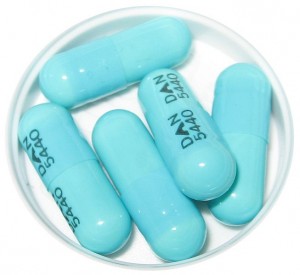WASHINGTON — More than 10 years after mailed envelopes of anthrax spores sent the nation into a panic, the federal government hasn’t stopped planning for another bioterrorism attack.
The Food and Drug Administration is weighing the possibility of developing a prescription antibiotic MedKit that consumers could pick up at the pharmacy, store in their homes and use in case of anthrax exposure.

The FDA is considering creating an anthrax MedKit that would include the antibiotic doxycycline. Photo via Wikimedia Commons.
The FDA convened a joint meeting of the Anti-Infective Drug and Nonprescription Drug Advisory committees last week to hear presentations by experts and public speakers, followed by a lengthy discussion about the implications of such a kit.
“The reason I’m up here today is that this sort of product has elements of an over-the-counter product, because it’s to be used in a situation where there may not be other real-time sources of information,” said Barbara Cohen, an analyst with the FDA’s Office of Drug Evaluation.
Cohen’s point is only the tip of the iceberg in the discussion.
As proposed, the FDA-regulated MedKit would include a 10-day supply of the antibiotic doxycycline, along with an instruction booklet and supplies for crushing pills and preparing the dose for children and others who aren’t able to swallow pills.
But who should have access to these kits? For their part, experts aren’t quite sold on the idea of the general public stockpiling large amounts of antibiotics in their homes.
In two previous studies on home antibiotic MedKits, one in St. Louis, conducted by the Centers for Disease Control and another by the Minnesota Department of Health, the majority of participants were able to properly store their MedKits and locate them upon request.
The CDC study was conducted in 2007. The survey period in Minnesota was from 2010 to 2011.
However, researchers in both studies say financial incentives and regular follow-up may have skewed the results. Tellingly, two participants in the St. Louis study reported that, though the instructions explicitly called for use only in case of a declared biomedical emergency, they used the pills in their MedKits to treat a sore throat.
Even if people are able to follow instructions for storage and use of the kits, there are some variables that the FDA will need to address.
“One factor not included in these studies was the stress of a real-time event on proper use of the kits,” said Jack Herrmann, a senior adviser at the National Association of County and City Health Officials.
Furthermore, the doxycycline in the kits doesn’t last forever.
“If you were to imagine 10 million MedKits being dispensed as proposed, with a one-year expiry,” said Dr. Andrew Pavia of the Infectious Diseases Society of America, “that’s 22 tons of doxy that must be safely disposed of every year and not flushed into the water supply.”
Support is stronger for a MedKit available by prescription only to emergency medical workers and their families. Even that option is fraught with issues, though.
“What would giving home antibiotics to first responders accomplish?” asked Dr. Michael Neely, an assistant professor of pediatrics at the University of Southern California. “What is the advantage of a first responder having it at home rather than a public point of distribution?”
Additionally, the MedKits would only include that initial 10-day dose of antibiotics, after which exposed people would have to procure the next 50 days’ worth of doxycycline to complete the treatment.
If points of distribution need to be set up to supply these doses and fill in the holes for people who don’t have MedKits in their homes, experts pointed out, there may not be a reason for home stockpiling at all.
Some committee members went as far as to question the need for a federally regulated kit to begin with.
“How many people think this is a problem?” asked Dr. T. Mark Woods, a pharmacist at St. Luke’s Hospital in Kansas City, Mo. “Are we creating a whole ad campaign to create a need? Is that the goal?”
“Should we really be spending so much attention on anthrax?” added Dr. Joan Hilton, an assistant professor at the University of California, San Francisco.
For its part, the Department of Homeland Security stresses that anthrax remains, “an enduring terrorist threat to the homeland,” per a presentation by department representative Dr. Susan Coller-Monarez.
“Historically, of the biological agents, bacillus anthracis [the anthrax bacterium] has been identified by adversaries as an agent of interest,” Coller-Monarez said. “The global distribution of bacillus anthracis is in places where there are individuals or groups of individuals who have demonstrated intent to do harm to the United States or our Western allies.”
Still, it’s not clear that there is a currently an imminent threat or a pressing reason to spend money and time developing a MedKit.
“The benefit is directly related to the risk of an anthrax attack,” said Dr. Walid Gellad, an assistant professor at the University of Pittsburgh. “If you told us there was a 95 percent chance an anthrax attack will happen in the next week, it’d be different.”
Despite all of the questions about who should have the kits, where they should get them or if bioterrorism is really at the top of public health risks right now, Dr.Winifred Landis, a pharmacist from Lafayette, Ind., pointed out one certainty.
“I really haven’t heard anybody say I love the kit the way it is,” she said. “I think you need to refine the product before we do studies on it, because otherwise we’re just kicking ourselves.”
